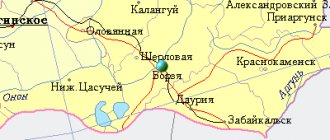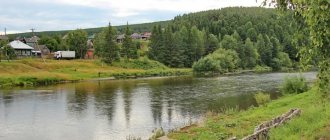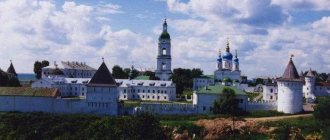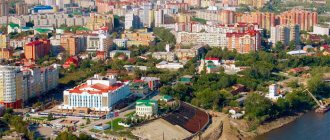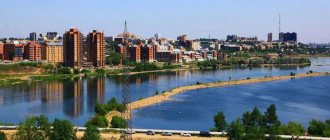Town in Kurgan Oblast, Russia
For other places with the same name, see Kurtamysh (localty).
Town in Kurgan Oblast, Russia
| Kurtamysh Kurtamysh | |
| City [1] | |
| Church of Peter and Paul in Kurtamysh | |
| Flag Coat of arms | |
| Kurtamysh | |
| Kurtamysh Kurtamysh Show map of Russia Kurtamysh Kurtamysh (Kurgan region) Show map of Kurgan Oblast | |
| Coordinates: 54°55'N 64°26'E / 54.917°N 64.433°E / 54.917; 64.433 Coordinates: 54°55'N 64°26'E. / 54.917°N 64.433°E / 54.917; 64.433 | |
| A country | Russia |
| Federal subject | Kurgan region [1] |
| Administrative region | Kurtamysh district [1] |
| City of district subordination | Kurtamysh [1] |
| Based | 1745 [2] |
| City status from | 1956 [2] |
| Government | |
| • Body | City Duma [3] |
| Region | |
| • General | 97 km 2 (37 sq mi) |
| Height | 110 m (360 ft) |
| Population (2010 Census) [4] | |
| • General | 17099 |
| • Evaluate (2018) [5] | 16 579 ( -3% ) |
| • Density | 180/km2 (460/sq mi) |
| Administrative status | |
| • Capital from | Kurtamysh district [1], Kurtamysh city of district jurisdiction [1] |
| Municipal status | |
| • Municipal district | Kurtamysh municipal district [6] |
| • Urban village | Urban settlement Kurtamysh [6] |
| • Capital from | Kurtamysh municipal district [6], urban settlement Kurtamysh [6] |
| Timezone | UTC+5 (MSK+2[7]) |
| Postal code [8] | 641430–641432 |
| Dialing code(s) | +7 35249 |
| OKTMO ID | 37616101001 |
| Web site | www.kurtadm.ru |
Kurtamysh
(Russian: Kurtamysh) is a city and the administrative center of Kurtamyshsky District in Kurgan Oblast, Russia, located on the Kurtamysh River 88 km (55 mi) southwest of Kurgan, the administrative center of the region. Population: 17,099 (2010 census); [4] 18,154 (2002 census); [9] 19,155 (1989 census). [10]
Links[edit]
Notes[edit]
- ^ abcdefgh Law No. 316
- ^ B s d "General information" (in Russian). Retrieved March 21, 2022.
- Kurtamysh City Duma
- ^ a b Federal State Statistics Service (2011). All-Russian Population Census 2010. Volume 1 [All-Russian Population Census 2010, vol. 1]. All-Russian Population Census 2010 [All-Russian Population Census 2010] (in Russian). Federal State Statistics Service.
- "26. The size of the permanent population of the Russian Federation by municipalities as of January 1, 2022". Federal State Statistics Service. Retrieved January 23, 2022.
- ^ abcde Law No. 419
- "On the Calculation of Time". Official Internet portal of legal information
. June 3, 2011. Retrieved January 19, 2022. - Post office. Information and computing center of OASU RPO. ( Post office
).
Search for postal service objects ( postal Search for objects
) (in Russian) - ↑
Federal State Statistics Service of Russia (May 21, 2004). The population of the Russian Federation as part of federal districts, urban settlements. [Population of Russia, its federal districts, constituent entities of the Federation, districts, urban settlements, rural settlements - administrative centers and rural settlements locations with a population of more than 3,000 people] (XLS). All-Russian Population Census of 2002 [All-Russian Population Census of 2002] (in Russian). - All-Union Population Census of 1989 Population of Union and Autonomous Republics, Autonomous Regions and Districts, Territories, Regions, Urban Settlements and Village District Centers [All-Union Population Census of 1989: Current Population of Union and Autonomous Republics, Autonomous Regions and Districts, Territories, Regions , districts, urban settlements and villages performing the functions of district administrative centers]. All-Union Population Census of 1989 [All-Union Population Census of 1989] (in Russian). Institute of Demography of the National Research University: Higher School of Economics [Institute of Demography of the National Research University: Higher School of Economics]. 1989 - via Demoscope Weekly
.
Sources [edit]
- Kurgan Regional Duma. Law No. 316 of December 27, 2007 “On the administrative-territorial structure of the Kurgan region,” as amended. Law No. 60 of July 2, 2015 “On amendments to the Law of the Kurgan Region” On the administrative-territorial structure of the Kurgan Region “”. Came into force after ten days from the date of official publication. Published: “New World”, Documents, issue No. 1, January 11, 2008 (Kurgan Regional Duma. Law No. 316 of December 27, 2007 “ On the administrative-territorial structure of the Kurgan region”
as amended by Law No. 60 of 2 July 2015 “
On Amendments to the Law of the Kurgan Region “On Administrative-Territorial Structure”).
Kurgan region " . Valid from the date of official publication.) - Kurgan Regional Duma. Law No. 419 of July 6, 2004 “On granting municipalities the status of a city district, municipal district, rural settlement, urban settlement, on the location of representative bodies of a municipal formation, urban settlement, on establishing the names of representative bodies of municipal formations, heads of municipal formations, local administrations. )", Ed. Law No. 70 of July 2, 2015 “On amendments to some Laws of the Kurgan Region.” Came into force on the date of official publication. Published: “New World”, No. 142, July 31, 2004 (Kurgan Regional Duma. Law No. 419 of July 6, 2004 On assigning the status of a city district, municipal district, rural settlement, urban settlement to municipalities; on establishing locations representative bodies of municipal formations, rural settlements; On approval of the names of representative bodies of municipal formations, heads of municipal formations, local administrations (executive bodies of municipal formations)
as amended by the Law of July 2, 2015 No. 70 “
On amendments to various Laws of Kurgan region
... Valid from the date of official publication.).
Heart of Kurtamysh
Two temples - two destinies
Among all the Trans-Ural settlements, Kurtamysh has always been famous for its spiritual and cultural history. The heart of Kurtamysh were two churches - the holy apostles Peter and Paul, which is over 200 years old, and the no less unique Church of the Resurrection, which was blown up after the revolution, has not survived to this day. During times of hard times, the clergy and parishioners of these churches were subjected to particularly severe persecution, arrests and executions.
“68 versts southwest of Mishkino lies the large village of Kurtamysh. The Kurtamysh settlement was founded in 1745 and was surrounded by a palisade and slingshots; in the 18th century it had up to 100 courtyards and a church in the name of Saints Peter and Paul,” wrote the famous Russian geographer Veniamin Petrovich Semyonov-Tien-Shansky.
Indeed, one of the most ancient, after the Karachel outpost, which arose in 1743, was the large settlement of Kurtamysh, founded in 1745. “The first settlers,” as stated in the “Orenburg Diocesan Gazette,” “were peasants who voluntarily migrated from the northern part of the Iset province, whose scarcity of land forced them to gradually move south and settle in free places.” The settlers who came in the middle of the 18th century chose the valley of the Kurtamysh River (the left tributary of the Tobol River), where they erected their first log cabins. After some time, Kurtamysh moved out among the surrounding villages and began to be called a settlement. Patriarchalism, inaccessible to outsiders, a calm, measured existence - these distinctive features were characteristic of the settlement until the middle of the 19th century. The first Kurtamysh peasants, along with the patriarchal way of life, brought with them the sprouts of the Christian faith, converting local pagan foreigners to their faith. Just seven years after the arrival of the settlers, in 1753, the first wooden church of the Holy Apostles Peter and Paul was erected in the settlement. No one then realized that this small church, built by unknown masters, would become a spiritual center for many miles around.
Kurtamysh peasants comprehended the Gospel and everyday truths like children - with all their hearts. Among them there were no preachers of the faith, no theologians, or even those who knew how to read and write well. Therefore, the first priests were chosen from among themselves - simple farmers. The peasants Chernodyrovs became ministers of the Church of Peter and Paul, replacing their surname after receiving the ministry with the Abrahamovs. They were elected as one of the most educated peasants in the settlement. But even they, poorly trained in literacy, had great difficulty in understanding Old Slavonic texts and could only read during sermons some chapters about the lives of saints from the meager church library at that time. However, the Abrahams put their whole soul into the ministry; their simple, ingenuous faith attracted many parishioners to the temple. The first and only center of spirituality appeared in the settlement, where not only Kurtamys residents, but also residents of surrounding villages and villages went.
It is known that one of the first priests of the Church of Peter and Paul was Mikhail Abrahamov; the Abrahamov dynasty survived in Kurtamysh and subsequently...
The wooden Peter and Paul Church existed for about half a century. In the spring of 1801, disaster struck - it burned down along with all the church documents. The parishioners could no longer imagine their lives without the temple, without the ringing of bells reaching all the nearby villages. Therefore, the parish council decided: “to immediately begin the construction of a new church, but this time made of stone and more magnificent.” On March 12, 1802, permission was received from the diocesan authorities to build the church. In the church chronicle of the Peter and Paul Church there is an entry: “This temple was founded on September 2, 1802, with the blessing of the High Priest Ambrose Bishop of Orenburg and Ufa by dean priest Vasily Feoktistov and local priest Roman Avramov with deacon N. Lytkin.”
The construction was carried out by the whole world; not only Kurtamys residents, but also residents of other villages took part in it. Construction ended in 1808. According to the plan, the temple turned out to be double-limited and surprisingly similar to the Trinity Cathedral in Kurgan (perhaps the Peter and Paul Church was designed according to Trinity's design). The main altar of the newly built church was, as before, dedicated to the apostles Peter and Paul and consecrated on June 28, 1808.
The new church was immediately filled with parishioners. At the end of the 50s of the 19th century, a bell weighing 70 pounds, weighing “rare in the purity and melodiousness of its ringing,” was purchased with church money. The Orenburg Diocesan Gazette contains a record of its erection: “In the absence of craftsmen and improved blocks, they decided to raise the bell in a primitive way: someone needs to sit on its ears to control the ropes and, together with the bell, soar to a considerable height, with the danger of falling or being knocked against wall... Hunters appear, challenging each other's honor... With a broad sign of the cross, admonished by confession and communion, the lucky one sits on the bell; the crowd swayed and hummed; the bell smoothly floated upward... The first sound rang out, and again the crowd of thousands swayed in prayer with one mouth and one heart...” Twenty years later, in the summer of 1862, a bell already costing 250 pounds was cast for the church. This giant was the only one in the Chelyabinsk district in terms of weight and sound power. Unfortunately, both bells have not survived to this day.
The main shrine of the Peter and Paul Church was and remains to this day the Abalatsk Icon of the Mother of God. It is a copy of an icon located in the Abalatsk monastery of the Tobolsk diocese and painted at the beginning of the 17th century according to the vision of the pious widow Maria by Protodeacon of the Tobolsk Cathedral Matthew. The copy of the icon, according to legend, was brought to Kurtamysh long ago by a widow for the healings revealed to her. Several cases of such healings were recorded in the parish chronicle: “the children of deacon Ivan Avraamov, the children of forester A. A. Kozhevetsky.” The miraculous icon has always been highly revered by local residents. Healings with her help still occur today.
No more than sixty years have passed since the consecration of the Peter and Paul Church, when the village residents began to need another church. By the 60s of the 19th century, people came to the Church of Peter and Paul from 22 villages of the Kurtamysh region. The church became increasingly crowded, especially on holidays.
The time has come to build a larger temple - a three-aisle one, which, according to the thoughts of the clergy, recorded in the church chronicle: “could correspond in dignity to the predominant position of Kurtamysh among the villages of the entire rich Chelyabinsk region.” The design of the large Nativity of the Virgin Mary Cathedral in Kurgan was taken as a basis. Upon receipt of permission from the diocesan administration, on June 27, 1867, the ceremonial laying of the stone three-aisle Church of the Resurrection followed.
The temple was built taking into account all the best that could be purchased, mainly with church funds. Five years later, the construction of the cathedral was completed.
The Church of the Resurrection was very fond of the parishioners. Despite the simplicity of its composition, it was distinguished by its monumentality and had a majestic appearance, located on an elevated open area, visible from many miles away. Kurtamysh, under the protection of two churches, increasingly prospered and developed until the revolution and the subsequent civil war broke out.
On January 19, 1918, Patriarch of Moscow and All Rus' Tikhon issued a message condemning the Bolsheviks and calling to resist them: “Come to your senses, madmen, stop your bloody reprisals. After all, what you are doing is not only a cruel deed, it is truly a satanic deed, for which you are subject to the fire of hell... We also adjure you, the faithful children of the Orthodox Church of Christ, not to enter into any communication with such monsters of the human race...”
For this message, Patriarch Tikhon was put under house arrest by the Bolsheviks; he, seriously ill, was tormented by daily interrogations until his death.
The Kurtamyshans showed extraordinary resilience and loyalty to the patriarch, suffering many times for their faith.
In the archival materials of the Kurgan Diocesan Council for the late 20s and early 30s of the 20th century, the Kurtamysh parish is repeatedly mentioned as a “nest of Tikhonshchina,” whose priests are “irreconcilably opposed to renovationism in the villages (the hegemony of the state over the church). Here is an example: “The rector of the Kurtamysh churches, Archpriest Alexander Zhukovsky, is the organizer of secret congresses of the Tikhonov society; a fanatic, an active organizer of Tikhonshchina ideas not only in the churches of his region, but also breaking into renovationist parishes (the retreat of the village of Dolgovsky to Tikhonovshchina was his doing).”
With the slogan “there will be no peace for the Tikhonovites, the top of the Tikhonovism is a counter-revolutionary tumor in the Church,” a series of bloody massacres swept across Kurtamysh. Many priests of the Peter and Paul and Resurrection churches were executed and tortured. Among the parishioners, the Bolsheviks organized “prevention against religion.” They rounded up all the local residents and ordered “those who are believers” to take a step forward. There were so many who took this step that they were shot with a machine gun. Kurtamysh was covered with corpses. But resistance and faith still did not fade away. Then in 1934 the Bolsheviks decided to blow up the largest Kurtamysh church - the Resurrection Church. The brickwork turned out to be so strong that only the vaults and ceilings collapsed. Even back in the 50s, in the very center of Kurtamysh one could see the ruins of a once huge old temple. The Peter and Paul Church miraculously survived; the Bolsheviks did not dare to touch it. Services in the temple continued until 1937, then a grain warehouse was installed in it, but this did not damage either the external or internal appearance of the temple; the local shrine was also preserved - a copy of the Abalatsk Icon of the Mother of God. Miraculously, on the eve of Easter during the war, in 1942, services were resumed in the church, which never stopped.
If you witness an interesting event, send messages, photos and videos to Viber and WhatsApp to phone number. : +79195740453, in our group “VKontakte”
Our Telegram channel
Vkontakte community
Yandex.Zen channel
External links [edit]
- (in Russian) Official website of Kurtamysh
- (in Russian) Unofficial site of Kurtamysh
| vteAdministrative divisions for the Kurgan region | |||
| Administrative center: Kurgan • Rural area. | |||
| Districts |
| ||
| Cities and towns |
| ||
| Urban settlements |
| ||
Kostylevo village and Ascension Church
The windows of ancient merchant houses were gilded by the setting sun. The photographs acquired warm shades.
We hurried to the neighboring village of Kostylevo . I liked the postcard from the set of attractions of the Kurtamysh region with the image of the Ascension Church in this village. Covering 20 km along a terrible, albeit paved road, I begged the sun not to fall so quickly below the horizon, I wanted to have time to take a few memorable shots of the flaming sunset. Everything has grown together! The sun has ears and a heart!
The church impressed with the size and whiteness of the restored walls. They say it is 150 years old, 33 of which it was a mill. We didn’t meet any villagers on the streets, except for the small offspring who smiled at us with all 10-12 teeth.
Having collected all the holes that appeared on the asphalt, we returned to the track and drove home to our native Kurgan . The trip was a success! The weather was kind, we ate the delicious pies at home, remembering the details of the trip.
So, we have paved the path to Kurtamysh for ourselves and there will definitely be postcards. Autumn in the Trans-Urals will soon swirl with the last golden leaves and a white creative streak will begin.
